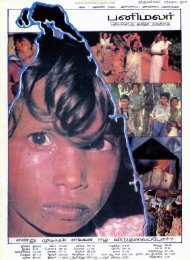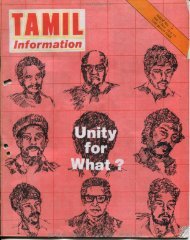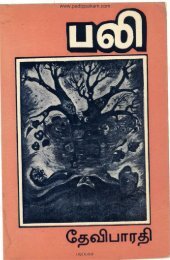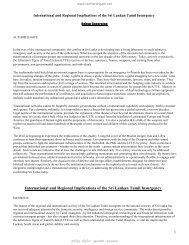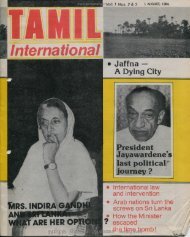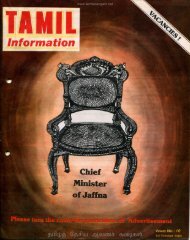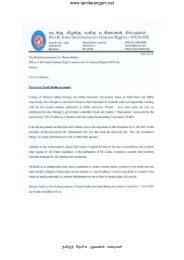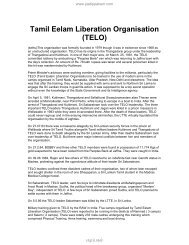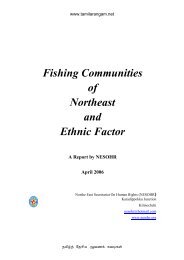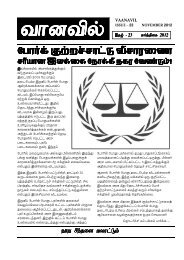Velupillai Prabhakaran: an illusive leader
Velupillai Prabhakaran: an illusive leader
Velupillai Prabhakaran: an illusive leader
You also want an ePaper? Increase the reach of your titles
YUMPU automatically turns print PDFs into web optimized ePapers that Google loves.
www.padippakam.com<br />
of each session of a new parliament. A supposition validated through Tiger theologi<strong>an</strong> Dr<br />
Balasingham’s assertion of <strong>Prabhakar<strong>an</strong></strong> as the “Prime Minister <strong>an</strong>d President of Tamil Eelam”, <strong>an</strong>d the<br />
Tiger <strong>leader</strong>’s soi-dis<strong>an</strong>t – Thalavar (national <strong>leader</strong>). Similarly in the absence of a parliament, a<br />
publicly visible revolutionary council or central committee, which make public policy statements, the<br />
Tiger Leader’s <strong>an</strong>nual speech offers the only reference to the LTTE’s ‘political’ st<strong>an</strong>ce.<br />
The tradition of <strong>an</strong> <strong>an</strong>nual speech dates back to 1991, 3 a year which marks the Tigers foray into battle<br />
field combat with operation “Tharai, Kadal, Aahayam” (L<strong>an</strong>d, Sea <strong>an</strong>d Air) – <strong>an</strong> event which elevates<br />
the status of Tiger controlled l<strong>an</strong>ds to that of a quasi Eelam state, equipped with its own military<br />
capable of mounting military offensives against the ‘occupying’ government forces. In this respect the<br />
decision to present <strong>an</strong> <strong>an</strong>nual speech is not only a politically prudent move that gives direction to the<br />
Tiger cadre in a new politico-military arena, but also a vital outward projection of statehood from the<br />
embryonic Eelam state.<br />
It should also be noted the address is incontrovertibly linked with the org<strong>an</strong>isations core motivational<br />
force – the sacrifice of its martyrs, <strong>an</strong>d it has become customary for the tiger <strong>leader</strong> to deliver his<br />
speech on November 27, the LTTE heroes day. Similarly with the reclusive nature of the Tiger <strong>leader</strong><br />
coupled with his increasing reluct<strong>an</strong>ce to gr<strong>an</strong>t media interviews, the <strong>an</strong>nual speech has become a rare<br />
portal into Tiger psyche.<br />
The speech traditionally broadcasted on the LTTE’s pulikalinkural – Voice of Tiger radio has, over the<br />
past fifteen years, increased its global reach through the adv<strong>an</strong>cements in satellite communication<br />
technology. In 2003, the LTTE broke new ground in this respect with a live telecast of the Tiger<br />
<strong>leader</strong>’s heroes day speech to Europe. Sunday Times journalist Chris Kamalendr<strong>an</strong> (November 30,<br />
2003) reported the broadcast had been facilitated through a satellite uplink from Killinochchi 4 provided<br />
by Rupavahini – the state television, as part of a political sweetener in the on going peace process of<br />
the time The report said “Rupavahini Chairm<strong>an</strong> Harim Peiris (had) confirmed that the live satellite<br />
broadcast, the first ever for the LTTE, was upon a request made by a foreign comp<strong>an</strong>y – the pro-LTTE<br />
Tamil Television Network (TTN), 5 ” Kamalendr<strong>an</strong> reported. The TTN television network based at 5 - 7<br />
Rue Emile Zola, 93120 La Courneuve, in the northeastern suburbs of Paris tr<strong>an</strong>smits its round-theclock<br />
broadcasts on the French based Eutelsat Hotbird satellites reaching a wide audience in Europe,<br />
North Africa <strong>an</strong>d Middle East.<br />
However, by early 2005 the Tigers had successfully developed their own satellite communication<br />
capabilities enabelling them to reach the international audience even without government consent. A<br />
supposition demonstrated through the launch of their own television network, the aptly named National<br />
Television of Thamil Eelam (NTT) from March 29, 2005. It was also reported the NTT broadcast was<br />
expected to be picked up by the TTN network <strong>an</strong>d tr<strong>an</strong>smitted to a wider audience (Tamilnet, March<br />
26, 2005) 6 . NTT programs initially unavailable to Asi<strong>an</strong> audiences was upgraded to cover parts of Asia<br />
on August 1, 2005 (Tamilnet, July 30, 2005). The tr<strong>an</strong>smission is now available on P<strong>an</strong>AmSat’s Pass-<br />
12 satellite <strong>an</strong>d enjoys a wider coverage in Europe, Middle East, Southern Africa, India, South East<br />
Asia 7 .<br />
Despite mounting opposition in the south the government officials said they were powerless to block<br />
the LTTE tr<strong>an</strong>smission. A media report quoting unnamed Telecom Regulatory Commission (TRC)<br />
3<br />
While the first publicly available tr<strong>an</strong>script dates back to November 1992, LTTE expert <strong>an</strong>d scholar on martyr ideology, Peter<br />
Schalk argues the tradition of <strong>an</strong> <strong>an</strong>nual speech was first started in 1991 (personal communication Peter Schalk, 2005)<br />
4<br />
“As the live coverage of the ceremonies were being aired on Thursday in Kilinochchi, footage of ceremonies held in<br />
Trincomalee <strong>an</strong>d Batticaloa were interpolated. It projected pictures of cemeteries, mourning family members of those who were<br />
killed in battle with security forces, street decorations <strong>an</strong>d the address by LTTE <strong>leader</strong> <strong>Velupillai</strong> <strong>Prabhakar<strong>an</strong></strong>.” The broadcast<br />
came just three weeks after President Ch<strong>an</strong>drika Kumaratunga took over the state media. (Kamalendr<strong>an</strong>, November 30, 2003).<br />
5<br />
“The network is said to have bureaus in Britain, Fr<strong>an</strong>ce, Switzerl<strong>an</strong>d, Germ<strong>an</strong>y, Denmark, Norway, Sweden, Holl<strong>an</strong>d <strong>an</strong>d India”<br />
(Kamalendr<strong>an</strong>, November 30, 2003).<br />
6<br />
“The satellite ch<strong>an</strong>nel will start today at 17.30 GMT time. We will beam only fifteen minutes of news everyday for the next two<br />
weeks. Thereafter our telecast time would be increased to half <strong>an</strong> hour”, he (a NTT official) said. The NTT official added that the<br />
Paris based Tamil Television Network (TTN) will relay the broadcast to their audiences in Europe at 18.00 GMT (Tamilnet,<br />
March 26, 2005).<br />
7<br />
(Source: P<strong>an</strong>AmSat - http://www.p<strong>an</strong>amsat.com/global_network/pas_12.asp <strong>an</strong>d LyngSat: PAS 12 at 45.0°E<br />
www.lyngsat.com/pas12.html)<br />
gbg;gfk;



